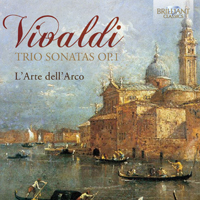|
| This is my post from this week's Tuesday Blog. |
Brilliant Classics Cover 2 Cover
As I’m sure many of you do, I receive my fair share of YouTube “Spam” mailings. Though some can be irksome and annoying, I’m glad I received a notice about the Brilliant Classics YouTube channel, where the label posts many of its releases integrally. I find that, for the most part, interpretations are generally pretty good. I have slated a few of these albums – starting with this week’s share – for some upcoming Tuesday Blogs.
Vivaldi’s Chamber sonatas for two violins and continuo
Accoirding to an excellent review I found as I was doing my background research for this week’s post, in 1681 Arcangelo Corelli published his first collection of trio sonatas which were to be followed by three further sets of twelve sonatas each. They were enthusiastically embraced by the music lovers and amateur performers at the time. The influence of Corelli's sonatas was such that almost any composer of later generations felt obliged to show his skills in trio sonatas of his own. A set of trio sonatas was often a composer's first publication of music from his pen. Examples are the trio sonatas by Albinoni, Bonporti and Caldara.
Vivaldi was another who decided that he should show the music world what he was capable of by publishing a collection of trio sonatas, publishing twelve trio sonatas his opus one in 1705. This edition has only partly survived; today's performers rely on a reprint by Estienne Roger of Amsterdam which dates from around 1715. However, it is assumed that the 1705 edition was in fact a reprint as well and that the first edition could have been from 1703 and may have been published shortly before Vivaldi had been appointed in his post at La Pieta in September of that year. Today’s share is a World premiere recording authorised and based on the Critical Edition of these 12 sonatas by Fabrizio Ammetto, Istituto Italiano Antonio Vivaldi, Fondazione Giorgio Cini, Venice.
Scholars have noted that Vivaldi's trio sonatas show some immaturity. That could be the reason that in our time they are not that often performed and recorded. It seems that in Vivaldi's time they didn't find a wide dissemination. It has also been suggested that the composer himself didn't rate them very highly as he hardly ever borrowed from them. Maybe he even didn't like the very form of the trio sonata as after 1710 he seldom returned to it.
Whatever one may think of these trio sonatas they make for good listening for about 90 minutes or so, certainly if they are played so well as here by L'Arte dell'Arco. One of the features of L'Arte del'Arco's playing is a great rhythmic precision; if you love baroque string music and/or Vivaldi you should add this fine performance of the corpus to your collection.
Happy Listening

Antonio VIVALDI (1678-1741)
12 Sonate da camera a tre, Op. 1
(Order on the recording)
No. 1 in G Minor, RV 73
No. 8 in D Minor, RV 64
No. 5 in F Major, RV 69
No. 10 in B-Flat Major, RV 78
No. 6 in D Major, RV 62
No. 12 in D Minor RV 63 “Follia”
No. 9 in A Major, RV 75
No. 7 in E-Flat Major, RV 65
No. 3 in C Major, RV 61
No. 4 in E Major, RV 66
No. 11 in B Minor, RV 79
No. 2 in E Minor, RV 67
L'Arte dell'Arco [Federico Guglielmo, Glauco Bertagnin, violin; Francesco Galligioni, cello; Ivano Zanenghi, theorbo; Roberto Loreggian, harpsichord, organ]
rec: March 12 -16, 2012, Carceri (PD), Abbazia di Santa Maria
Brilliant Classics - 94784BR
More info: http://www.brilliantclassics.com/art...io-sonatas-op1
Internet Archive URL - https://archive.org/details/LArteDellArcoVivaldiTrioSonatasOp.1

No comments:
Post a Comment